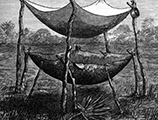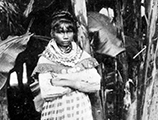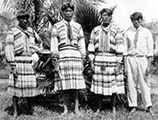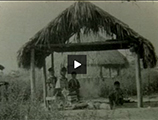The Florida Seminoles
Lesson Plans
The Seminoles and Pioneer Life in Florida
4th Grade Lesson Plan
Background Information
At the end of the Seminole Wars in 1858, only about 200 Seminoles remained in Florida. The Seminoles rebuilt their communities. They became part of the economic and cultural development of the Florida frontier. Beginning in the 1920s, some Seminole families worked at tourist villages. Mikasuki-speaking Seminoles operated their own tourism-related businesses along the Tamiami Trail.
At first, few Seminoles relocated to the reservations established in the 1920s and 1930s. This began to change as the government developed employment opportunities on the federal lands. By the late 1930s, cattle, land improvement, health, education, and handicraft programs were in place.
The Seminole Tribe gained federal recognition in 1957. The Miccosukee Tribe gained federal recognition in 1962. Some Florida Indians refused to join either Tribe and stayed independent.
These photographs show examples of Seminole clothing, food, housing, family, and work.
Clothing: Seminole clothing changed over time as they acquired new materials (brightly colored cloth) and technology (sewing machines). Seminoles made traditional clothing and also borrowed from styles they saw in American settlements.
Food: Seminoles ate a variety of plants and animals that exist in South Florida, including deer, alligator, manatee, bear, turkey, fish, fruits, and vegetables. Seminoles captured or gathered most of their food until the late 1800s/early 1900s when they started visiting frontier trading posts.
Housing: Seminoles generally lived in thatched-roof structures called chickees. Most chickees had palm-thatch roofing, but some used cypress bark or metal. Most chickees had open sides, but some were enclosed with wood logs or palm-thatching. Some Seminoles live in chickees today, but most moved into concrete block or frame construction homes beginning in the 1960s. Many Seminoles build chickees near their homes for outdoor cooking and recreation.
Family: Seminoles lived in extended family camps dominated by matriarchs. All women in a Seminole camp shared the same clan and a man moved to his wife's camp when they married. Some Seminole families maintain their matrilineal traditions today, but others have adopted a patrilineal pattern common among other ethnic groups in the United States.
Work: Seminoles farmed, hunted, worked in tourism, and on government programs. Tourism and government jobs came about in the period after 1920.
Purpose
The purpose of this primary source set is to introduce students to Seminole culture from frontier times to the 20th century.
Materials Needed
- Photopraph and Motion Picture Analysis Worksheets from the National Archives and Records Administration
- Photograhs and video of the Semionoles in pioneer Florida (above)
Next Generation Sunshine State Standards
- SS.4.A.1.1: Analyze primary and secondary resources to identify significant individuals and events throughout Florida history.
- SS.4.A.4.2: Describe pioneer life in Florida.
Florida Standards
- LAFS.4.RI.1.1: Refer to details and examples in a text when explaining what the text says explicitly and when drawing inferences from the text.
Procedure
Part I: Introducing Content
- Begin by reviewing what students know about the pioneer experience.
- Develop a working definition of a pioneer.
- What experiences were common to all pioneers?
- Did the pioneer experience differ from one ethnic group to another?
- Conduct an in-class discussion/survey of students' prior knowledge of the Florida Seminoles.
- Where did the Seminoles come from?
- Where did they live?
- What did Seminole clothing look like?
- Provide brief historical context on the Seminole Wars and Seminole relocation to South Florida (see "Photos and a Brief History" included with this unit). Explain to students that, like other Americans, white and black, the Seminoles were pioneers in the development of South Florida. Tell students they will be learning about Seminole pioneers and their way of life.
Part II: Photo Analysis
- Prompt students to think about the pioneer experience.
- Students can make a short list, alone or in a group, about the things they associate with pioneer life.
- Students should record their thoughts on the photographs using the Primary Source Analyzing Tool, paying special attention to what they think these images tell us about Seminole pioneers.
Part III: Describing Daily Life for Seminole Pioneers
- Break students into small groups and instruct them to take note of things in the photographs that interest them.
- The teacher can build a master list with student input in order to reconstruct daily life for Seminole pioneers. To build the list, teachers should focus on questions like:
- What did Seminole clothing look like? How did men's clothing differ from women's?
- What did Seminoles eat? How do you think their diet compared with other pioneers in Florida?
- Where did Seminoles live? What type of houses did they build?
- What types of families did Seminoles have?
- What type of work did Seminoles do?
Part IV: Writing About Seminole Pioneers
Students should write brief journal responses to the photographs based on what is interesting to them. Teachers may prompt students with questions like: What is the most interesting thing you learned from the photographs?

 Listen: The Assorted Selections Program
Listen: The Assorted Selections Program



